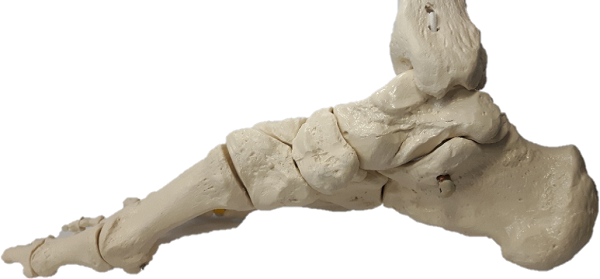
Bone Spurs in the Foot
What is a bone spur?
A bone spur is a bone growth on a structure attaching to the bone. This structure may be a tendon, which attaches the muscle to the bone, or growth on or between bones.
Bone spurs occur with abnormal and prolonged stress to the bone or attachment. In the foot, the most common areas for a bone spur from a tendon are at the bottom of the heel and the back of the heel.
Plantar Fascia Bone Spur
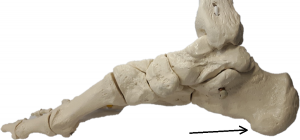
The plantar fascia starts at the ball of the foot (metatarsals), and attaches to the inside of the heel (calcaneus). At the bottom of the heel, the bone spur occurs on the plantar fascia attachment to the heel bone (calcaneus). Although not a tendon, the plantar fascia is constantly pulled during the walking cycle.
The cause of the plantar fascia bone spur generally occurs due to flat or overpronated feet. The plantar fasciitis blog post in January 2019 explains how
the plantar fascia moves in detail. Essentially, the plantar fascia pulls and relaxes while walking, and a flat or overpronated foot exaggerates this. When constantly overstretched, the body responds to prevent injury. Because bone is stronger, it will grow along the plantar fascia band to increase the strength. Although this strengthens the band, it may reduce the amount of stretch available and reduce the range of motion available.
Achilles Tendon Bone Spur
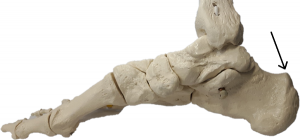
The Achilles tendon attaches the calf muscles (gastrocnemius and soleus) to the back of the heel (calcaneus). The bone spur occurs on the Achilles tendon attachment to the heel bone (calcaneus). When the calf muscles contract and relax, the Achilles tendon will pull and relax as the muscle does.
Like the plantar fascia, the cause of the Achilles tendon bone spur generally occurs due to flat or overpronated feet. When the foot pronates, especially the heel, the calf muscles activate to pull the heel into a neutral or straight position. When the Achilles tendon cannot handle overworked or overstretched calf muscles, the bone spur develops to increase strength at the Achilles tendon attachment site.
Other Bone Spurs
Bone spurs may also develop on a bone due to constant trauma. Common areas in the foot are the first MTP joint (big toe), the sesamoid bones (under the big toe) and the dorsal midfoot (top of the foot). This type of bone spur is also a response to stress in the area to strengthen it, but typically causes pain due to the result of a larger bone. With a larger bone, more pressure occurs and typically causes pain and/or a lack of motion to the area.
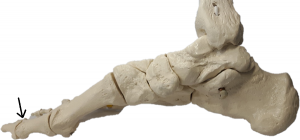
The first MTP joint bone spur may develop due to excessive motion to the joint. Excessive motion may occur due to a flat foot or overpronation, which causes the foot to push off on the inside of the big toe (hallux). When pushing off of the inside of the hallux, the first MTP joint hits bone on bone to cause the spur to develop over time. Eventually, this may lead to a fused and painful joint.
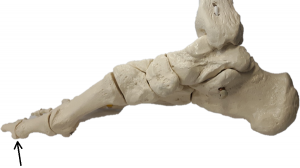
The sesamoid bones develop bone spurs when there is excessive and constant pressure. This pressure typically happens due to a high arch or a medial toe off (push off on the inside of the hallux).
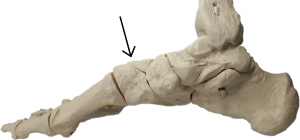
The dorsal midfoot also develops a bone spur with excessive and constant pressure. A high arch will cause this due to the high instep rubbing against the top-inside of a shoe.
Do I have a bone spur?
A diagnosis is confirmed through an x-ray or CT scan. These bone spurs could be asymptomatic/present with no pain, and may be discovered through a scan searching for the cause of a separate issue.
In the case of an asymptomatic bone spur, it could mean the area is under stress but not enough to cause pain, or the area was under stress and the bone is now strong enough to prevent more damage.
Symptomatic bone spurs present as pain in the area of the spur. The pain can be reproduced by loading the area (such as walking or other activities), or by pushing directly on the area.
How do I treat my bone spur?
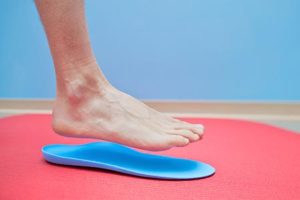 The only way to remove a bone spur is through surgery. To avoid this, there are other ways to manage the pain, and prevent the spur from worsening. Even after surgery, it may return if the cause has not been dealt with.
The only way to remove a bone spur is through surgery. To avoid this, there are other ways to manage the pain, and prevent the spur from worsening. Even after surgery, it may return if the cause has not been dealt with.
As a Pedorthist, the treatment typically involves custom foot orthotics. The orthotics support the foot to prevent overpronation and other abnormal mechanics that cause strain or pressure to the structures. In some cases, footwear modifications or recommendations are necessary to prevent pain.
If this sounds like the condition you have, or you would like more information, let us know!
You must be logged in to post a comment.

Comments (1)
Pingback: Plantar Fasciitis - What, Why, and How | On the Ball Orthotics